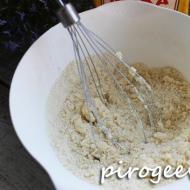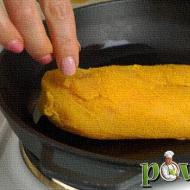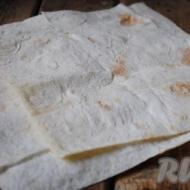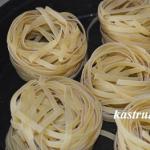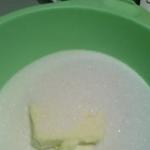
What kind of refrigerator will be used for a moonshine still? Purpose, principle of operation, how to do it yourself. Types and capabilities of refrigerators for moonshine stills. What and how to make it with your own hands? Buy moonshine cooler
There are two types of capacitors: coil and direct-flow.
A coil is a tube coiled into a spiral. Due to its considerable length, the steam passing through it has time to cool to the condensation temperature. The efficiency of this design directly depends on the length of the tube used to create the coil.
The easiest way to think of direct flow is as a tube through which steam flows, inserted into a tube with a cooler. There are a variety of variations: a tube with several thickenings throughout, a straight tube, a tube bent in a zigzag, and so on. But the point remains the same: it is important that the area of the inner tube be as large as possible. Then it will be possible to transfer more energy (heat) from the steam to the cooler.
Refrigerator materials
A refrigerator for a moonshine still is made from a variety of materials. But the four most popular are:
- Stainless steel;
- Copper;
- Aluminum;
- Glass.
The first material is found on almost every factory-assembled moonshine still. It was chosen due to its price and ease of cleaning.
Copper is found in more expensive models. Has much higher thermal conductivity. In order to condense the same amount of alcohol from steam, all other things being equal, you will need much less copper tube. Through it, heat is removed more efficiently, due to which alcohol passes from gaseous to liquid state earlier.
Aluminum is a popular material. Almost any homemade moonshine still cooler consists of it. And all thanks to adequate thermal conductivity, low price and easy availability of aluminum tubes.
Glass. Conducts heat well. In addition, it is also transparent, thanks to which you can control the condensation process. It's impossible to do it yourself. Sold in chemical supply stores.
How to make a refrigerator for a moonshine still
To begin with, we suggest deciding what we need: autonomy or efficiency. There is no middle ground here. The exception is the homemade “Kulibins”, when the coil is immersed in a river, which provides cold running water. But this option is too complicated, so we will not consider it. Our task is to make a copy of the refrigerator with minimal expenditure of time, effort and money.
Autonomous cooling for moonshine still
An autonomous cooling system is not that difficult to manufacture. We will need a coil already bent into a spiral, a bucket, fum tape, plasticine, a drill and a metal drill. The diameter of the drill is equal to the diameter of the coil tube.
To begin, we insert the coil into the bucket and try on where its lower end will come out. Make a mark on the bucket and drill a hole in this place. Now we insert the coil into the seat, connect it to the moonshine still, and only after that isolate the place where the coil exits the drilled hole. For insulation, fum tape is ideal, wound in several layers with a wedge around the place where the tube comes out of the bucket. If this seems not enough to you, then you can additionally coat the joint with plasticine. And only after completing all the above operations can you pour water into the bucket. Now we periodically test the water in the bucket with our finger. As soon as it heats up, it needs to be cooled down immediately. To do this, simply select the heated one and pour in the cold one. The system is simple and straightforward.
You can make a small improvement: drill another hole in the side of the bucket and insert a drain valve into it. You won’t need a lot of time and money, but it will save you nerves and effort!
Stationary system
Now we will make a flow cooler for the moonshine still. Moreover, we will only have to spend money on the tube and electricity. Everything else can be obtained for free. So, we need:
- 1 meter silicone tube;
- 1 liter plastic bottle;
- Autogen gas lighter (turbo lighter);
- Scissors.
So let's get started. First, we make a hole in the bottom of the bottle the same size as the silicone tube. By the way, you need to use a silicone tube. Rubber and its ilk may affect the taste or benefit of the final product.
Now we insert a third of the hose through the neck and take out its small end on the other side. By the way, the removed end can already be fixed by fusing the hose and plastic together. Now we begin to rotate the end that comes out of the neck around the longitudinal axis. Under the influence of twisting forces, the hose will begin to twist into a spiral. Now, continuing to twist, we gradually insert the hose into the bottle. Ideally, it should remain in the form of a spiral even after fixing both ends. After this, we wrap the fum tape on the remaining end in a layer sufficient to form a cork that can plug the neck of the bottle.
The next step is to burn two holes in the side of the bottle. One is at a distance of 5 cm from the neck, and the second is at a similar distance from the bottom. In both resulting holes we insert a pipe through which coolant will flow.

Conclusion
Using the schemes described above, you can make a refrigerator for a moonshine still with your own hands in a matter of minutes. Each of them will take no more than an hour to make. And they will function no worse than purchased samples for tens of thousands of rubles.
As for the calculations for the refrigerator, they are not needed. The main thing is that the diameter of the tube is at least 10 mm, and its total length is at least 1 meter. If the coolant is flowing, then this is enough. For a system with a bucket, you will have to take a longer tube - 2 meters and it is important that it is made of metal.
A coil is an essential part of a moonshine still, designed to condense alcohol vapor by removing heat with water or air through the walls. Despite the complex definition, anyone can make a coil at home. The homemade version will work no worse than store-bought counterparts. We will look at the theory and practice of manufacturing.
Coil parameters:
1. Material. The most important factor influencing the safety and taste of moonshine. The coil material must not react with alcohol or be toxic, but still have sufficient thermal conductivity to allow alcohol vapor to condense.
Taking into account the requirements, you can make a coil from copper, aluminum or stainless steel. Glass is also a suitable material, although it is easier to buy a ready-made glass coil at a chemical store than to make something similar yourself.
Copper has the best thermal conductivity, but many moonshiners consider it a toxic material; in fact, this is not the case. For example, for several centuries the French have been distilling all strong alcohol in alambiks - special copper distillers, and so far no one has been poisoned. Aluminum takes second place in terms of thermal conductivity (1.6 times worse than copper), but it is relatively cheap, accessible and easy to process. Stainless steel coils are 3-4 times inferior to copper ones; moreover, the exact brand of stainless steel is not always known, and only food-grade ones are suitable for home brewing, which can withstand high temperatures and do not react with alcohol.

 Copper coils are the most efficient
Copper coils are the most efficient 2. Dimensions. The longer the tube, the larger the area of contact between vapor and water (better cooling), but at the same time the hydraulic resistance increases (the distillation speed decreases). The correct length of the coil in a moonshine still (the tube itself before curling) is 1.5-2 meters.
The larger the cross-section (inner diameter) of the tube, the larger the contact area and the lower the resistance. I recommend using a tube with an internal diameter of 8-12 mm.
The small thickness of the coil wall increases thermal conductivity, improving condensation, but tubes that are too thin are difficult to process and operate because they are very fragile. In addition, when two media come into contact, in our case condensed alcohol and steam, the thermal conductivity drops sharply, regardless of the size and material of the wall. The optimal thickness of the coil tube is 0.9-1.1 mm.
3. Orientation in space. The coil can be positioned vertically, horizontally or obliquely. In moonshine brewing, it is desirable to use a vertical connection scheme, in which the condensed distillate flows by gravity and does not create additional obstacles to the movement of steam.
Vertical coils can be ascending (steam goes from bottom to top) or descending (from top to bottom). For minimal resistance, steam should be supplied from above.
4. Cooling system. The coils are cooled with water, ice and air. The last two options are less effective and require complex structures, so we will not consider them further. Water cooling systems can be open - they work on running water, and closed - the tank is immediately filled with the required amount of water. The design of closed systems is simpler, but they cool worse; the moonshine often comes out warm, and after a couple of hours of distillation, even hot.
In open systems, water circulation cools the coil much better, and the moonshine turns out cold. In addition, flow-through designs use a smaller volume water tank, resulting in a more compact device.
It is correct to supply water from below and remove it from above. For normal cooling, the water must move towards the moonshine, otherwise the lower part of the coil will not cool well. This scheme is called "counterflow mode".
Coil manufacturing technology
You will need a copper, aluminum, brass or stainless steel tube 1.5-2 meters long, with a cross-section of 8-12 mm and a wall thickness of 0.9-1.1 mm. I advise you to find a housing (reservoir) in advance to install the coil. The coiling diameter of the pipe depends on the size of the housing. For example, a plastic sewer pipe with a diameter of 75-80 mm is suitable. For effective cooling, the coil must occupy at least 15-20% of the tank volume.
The coil installed in the housing is called the refrigerator of the moonshine still, the drawing is shown in the photo. 

Subsequence:
1. Fill the tube tightly with dry bulk material, for example, river sand or soda, so that the metal does not flatten when curling. As a last resort, you can fill the tube with water and freeze it.
2. Place wooden choppers (pegs) on the ends of the tube. An alternative is to solder or clamp tightly. It is advisable to weld a nut on one end.
3. Wind the tube onto any smooth object with an even circular cross-section of the required diameter (in the example, 35 mm) with a pitch between turns of 12 mm.


4. Release the ends of the coil, pour out sand, and rinse with running water.
5. Install pipes for water supply and drainage on the cooler body.
6. Place the coil in the housing, install plugs at the top and bottom, and seal all connections with superglue or another method.

 Finished metal refrigerator
Finished metal refrigerator Before moving on to a consideration of the refrigerator manufacturing technology, it is necessary to say a few words about what this structural element is used for and what it represents. To begin with, it is important to understand the very principle of operation of a moonshine still.
- The prepared and fermented mash is placed in a distillation cube.
- When it is heated to a certain temperature, it evaporates. The essence of the process is that the evaporation temperature of alcohol is slightly lower than that of water or the bulk of fusel oils, therefore an initial separation into its constituent components occurs.
- Alcohol-containing steam moves through a system of tubes into a cooler, inside which the steam condenses and the output is moonshine.
This description is simplified as much as possible, since the design of a moonshine still usually contains additional elements, such as a steamer or a bubbler, but in the context of the article, their consideration is inappropriate.

Moonshine still design
So, one of the main stages of obtaining a distillate, which is moonshine, is the condensation of alcohol-containing steam. In order for this process to occur more intensively, a refrigerator for a moonshine still is designed.
Refrigerator design
As for the technological device, the cooler most often consists of a coil and a sealed reservoir with circulating coolant. There are other manufacturing options, but it is the direct-flow refrigerator that is most efficient combined with simplicity of design, and therefore manufacturing. For a more complete understanding of the issue, it is worth considering it in a little more detail.

Refrigerator coil
The coil's twisted shape allows it to cool the steam on its own. There are varieties of refrigerators in which the cooler is not equipped with additional chambers, and the process occurs upon contact with air. The efficiency of such a system will be lower than when using a full-fledged refrigerator, but it will work. The presence of an additional chamber is due to the fact that during operation the coil heats up from the action of steam, so it is not enough to simply pour water inside the chamber. The cooler must be direct-flow, since only in this way will it be possible to ensure the constant temperature necessary for effective condensation of alcohol-containing vapors.
So, a refrigerator for a moonshine still that is optimal in its functionality should consist of the following elements:
- A sealed tank, the dimensions of which will be sufficient to accommodate a coil inside it and sufficient for water circulation. You can often see refrigerators with stainless steel tanks, but recently systems using elements made from polypropylene pipes are gaining popularity due to their simplicity of design.
- The coil itself is made of a material that is resistant to mash vapors, as well as water, and is not prone to deformation under the influence of temperature changes. You can make a refrigerator for a moonshine still with your own hands using a coil made of a copper tube, a stainless steel tube or a polyethylene tube.
- Two valves for water inflow and outflow.
As for the coil, its extreme end, which extends from the wall of the refrigerator and is the outlet for the entire system, can be equipped with a tap that will allow the system to be shut off, which is important when the device is not in use.
Making a refrigerator
Making a refrigerator for a moonshine still is not so difficult if you know the technology for assembling this element. The tank itself can be made, for example, from stainless steel or polypropylene plumbing pipes. If we take into account the difficulties in working with stainless steel (it is difficult to weld elements) and the prevalence of polypropylene today, then the second option would be more appropriate. It will be discussed below.

Let's take a polypropylene pipe as a base.
Tools and materials
In order to make a direct-flow cooler, you will need a small set of tools and a certain amount of polypropylene elements used in plumbing.
- Plumbing plugs – 2 pcs.
- Plumbing coupling suitable for diameter plugs – 1 pc.
- Connecting element with coupling and narrowing at the ends – 1 pc.
- Cable gland PG-29 – 2 pcs.
- Plumbing fitting – 2 pcs.
- Copper or corrugated stainless steel tube about 2 m long
- Feather drills
- Silicone sealant
- adjustable wrench
- Screwdriver or drill
The entire set can be easily purchased at a plumbing store without requiring a large investment.
Build process
If all the tools and materials are ready, you can proceed to the assembly process. The work should be divided into several stages, which must be performed sequentially.

At this point, the main stages of work on assembling the refrigerator for the moonshine still can be considered completed. All that remains is to connect the coil to the rest of the system and run water through the fittings. Moreover, it is worth paying attention that the water circulation should be organized in such a way that the upper valve will be the outlet and the lower the inlet. This way the system will function most efficiently.
In conclusion, it is worth adding that the homemade refrigerator for the moonshine still obtained as a result of the described manipulations will not be inferior in functionality and efficiency to analogues manufactured at the factory. It is only important to show a little diligence and comply with the necessary assembly conditions.
Moonshine is probably drunk by at least half of Russian families. Even if you’re not keen on the process, you’ve at least once tried to make your own high-grade product, which compares favorably with store-bought ones and costs several times less.
Let's take a closer look at how to make a shell-and-tube refrigerator with a polypropylene pipe as a body.
Plumbing items you will need:
- two-meter pipe with an internal diameter of 70 mm. This calculation is very important, since there will still be a coil inside, and the amount of water flowing should provide effective cooling;
- 2 matching polypropylene plugs;
- 1 coupling suitable for the plug;
- 1 connecting element, which tapers towards the end, with a coupling;
- 2 cable glands PG-29;
- 2 matching fittings;
- approximately 2 meters of tube. Corrugated stainless steel or copper will do.
You will also need a drill or screwdriver, feather drills, strong glue and silicone sealant.
Assembly
- First, you need to take the plugs, mark 2 holes so that after installing a fitting and an oil seal in each of the plugs, the nuts with which you will fix them do not interfere with each other.
- Drill holes.
- Pull the tube (future coil) into one of the seals almost to the end. Tighten the locking ring.
- Secure each plug with a fitting and an oil seal (including the one with the tube), making sure to seal it with sealant.
- We form a coil by winding the tube onto a suitable round-shaped object.
- We pass the end of the coil through the coupling.
- We connect the outer casing (pipe) with the coupling and the second element and put it on the coil.
- We install plugs on the glue and seal the joints.
Note. If you use a copper tube for a coil, you must first fill it with sand and cap it on both sides (flatten it, insert wood plugs), otherwise during the winding process the inner walls of the tube may touch and such a coil will have to be rejected.
After winding, the sand is poured out and the tube is washed with water.
After which the direct-flow refrigerator for the moonshine still is ready. In terms of functionality, it is completely not inferior to those manufactured in the factory. But the cost price will please you.
Upon completion of all work (including sealing), be sure to, before putting the cooler into operation, check it for leaks, passing a certain amount of water through it.
Making a dimrot cooler
If you want to buy a Dimroth refrigerator, most often it will be made of glass.
The device is really effective, but fragile, because it is a glass refrigerator, even if it is made of tempered glass. I knocked it carelessly, dropped it, and that’s it... But it’s quite possible to create a homemade one, for example - stainless steel.
Why this material? Firstly, food-grade stainless steel is inert to various oils, acids and other impurities that are in the mash. Secondly, it is reliable and quite easy to process.
To make a reflux refrigerator, you will need:
- about 2.5 meters of stainless tube 6 mm in diameter;
- pipe and covers for the housing - 70 cm in diameter, about 1.9 meters high:
- 2 tubes for water connection and 1 for atmospheric connection;
- soldering iron and solder.
When winding a tube, it is important to consider that it two-layer, consists of an inner and outer layer. The inner layer has 14 turns, with a gap of 2 mm between them, while its internal diameter should be 20 mm. There are 8 turns in the inner layer, and the gap between them is 6 mm.
There should be a gap of 3 mm between the inner and outer spirals for free cooling. The total external thickness of the wound tube is 50 mm. The height of the system is approximately 115 mm.
Using a dimroth cooler, you will no longer receive a distillate, but a rectified product - almost completely devoid of harmful impurities and the taste of the components included in the mash.
Now you are convinced that making a refrigerator for a moonshine still is not such an impossible task. Share information with friends on social networks, add comments and tips!
How to make your own refrigerator for a moonshine still?
When you assemble a moonshine still with your own hands, you need to think in advance and decide whether you are going to use a laboratory refrigerator, which is sold in stores ready-made, or a homemade refrigerator.
Today we will talk about how to make a refrigerator for a moonshine still. We will pay more attention to the straight-through refrigerator, since it is simpler and more convenient.
You can make a refrigerator for a moonshine still with your own hands using this design in an hour. You will have to spend less than 1000 rubles on consumables.
What types of refrigerators are there?
There are two types of refrigerators for moonshine stills - direct flow and coil. Folk craftsmen most likely invent a variety of designs, depending on who has the imagination, but in this article we will talk specifically about the classic options.
A straight-through refrigerator for a moonshine still is a straight metal tube (copper or stainless steel), with a casing placed on top of it (you can use another pipe). The inner tube is intended for moonshine, and coolant (usually water) flows through the casing. It is also called a shell-and-tube refrigerator.
A coil is the same tube, only it curls into a spiral. The tube is placed in a housing with a coolant (water). The main advantage is that this is a static refrigerator, meaning it does not require running water.

There is also a glass refrigerator. It is impossible to make it yourself, but it is sold in stores. Some people also use such a refrigerator when assembling a distiller, but glass is a very fragile material and is easy to break. This is most dangerous during the distillation process, since the vapors and condensation of moonshine can easily ignite. Therefore, it is still better to use metal devices.

Coil or direct flow?
Advantages of a direct flow over a coil:
- condensate plugs do not form, leading to pressure fluctuations in the distillation cube. Due to pressure changes, the mash can suddenly boil and be thrown into the refrigerator. This happens quite often in coils. In the direct flow, temperature regulation is possible and it instantly responds to changes in the coolant supply.
- the efficiency is higher, which means less water is consumed.
Advantages of the coil:
- small size;
- In some designs, running water may not be used.
How to make a direct flow?
The cheapest and most accessible option is a refrigerator made using polypropylene pipes and fittings. Materials for manufacturing can be purchased at any hardware store. Costs in total will not exceed thousands of rubles.
To make a simple refrigerator for a moonshine still, you don’t need any special equipment, and it will take about an hour.
Option No1.
You will need:
- copper tube 12x1 1 meter long;
- polypropylene pipe with a diameter of 25 mm - 1 meter;
- tee with transition to internal thread 25×1⁄2″ – 2 pcs;
- adapter coupling 20-25 mm - 2 pcs;
- threaded plug 1⁄2″ - 2 pcs;
- threaded fitting 1⁄2″ for connecting a hose with a diameter of 12 mm - 2 pcs;
- FUM tape.
Assembly instructions
The assembly diagram is very simple. You need to cut a piece of 55-60 cm from the polypropylene pipe. This is the future casing. Tees must be put on the ends of the pipe. According to technology, such pipes need to be connected using a special apparatus. But this thing is quite expensive, and buying it just to make a moonshine still is irrational, so there is a folk method. The tee should be placed in boiling water and kept there for several minutes. Then quickly, without allowing it to cool, put the part on the pipe. It's better to wear gloves to avoid getting burned.
In the same way you need to put on the adapter coupling.
In the center of the threaded plugs, you need to drill a hole into which the copper tube will fit with as little clearance as possible.
Now you need to heat the couplings and hammer the plugs into them.
The fittings are screwed into the tees, and the threads must be sealed with FUM tape to prevent possible leakage.
The casing is done. Now you need to cut the copper tube so that it protrudes from each side of the casing by 2-3 cm. The tube must be inserted into the jacket through the holes in the plugs. The cracks must be sealed with sealant.
The refrigerator is ready. It can be connected to the distillation cube with a silicone hose.
Option No2. Almost the same, only the copper tube is 10 mm and the polypropylene pipe is 20 mm. When using this design, adapter couplings are not needed; the plug must be inserted directly into the tee.
Such a refrigerator is somewhat cheaper, but the throughput also decreases.
How to choose the optimal size of a once-through refrigerator?
The most optimal dimensions for a direct-flow refrigerator are: casing length 500-600 mm, gap between tubes 1-15 mm.
When purchasing materials, pay attention to the wall thickness of the polypropylene pipe. You need to take it so that the internal diameter is approximately equal to the diameter of the copper pipe plus two to three mm.
The thickness of the walls of the copper tube is also of no small importance. The smaller it is, the better the heat is removed from the steam. It is not recommended to take a tube with walls thicker than 1 mm.
The coolant (water) must meet the steam. The water must be connected on the other side of the steam connection.
Ideally, a direct-flow refrigerator should stand vertically. In this position, the moonshine condensate flows freely downwards. It is in this position that the direct-flow refrigerator will have maximum efficiency, and condensation plugs will not appear.
Do not forget to clean the copper tube after each distillation. It is better to do this with a brush, but you can simply wash it with hot water under pressure. If this is not done, then copper sulfate will appear in the tube, which is poisonous to the body.
How to make a coil?
You need to take a copper tube (a stainless steel tube is also suitable) 10-12 mm. The tube should be 120-150 cm long. The walls of the tube should be from 0.8 to 1 mm. If the walls are thinner than 0.8 mm, then the tube can easily be damaged during the manufacture of the refrigerator. If the thickness is more than 1 mm, then it will be difficult to bend the tube, and it also conducts heat worse.

When you buy a pipe, be sure to ask for an annealed one. It is impossible to bend an unannealed tube, so it is not suitable for a refrigerator.
At one end the tube must be soldered or plugged with a wooden plug. Then you need to pour sand or soda into the tube. You need to fall asleep tightly. This is necessary so that the tube does not flatten when you bend it. If you decide to fill in sand, then use very fine sand. Coarse sand will then be difficult to remove. Instead of sand or soda, you can pour water and freeze. After which the other end of the tube must also be plugged.
 Diagram of a standard moonshine still with a coil
Diagram of a standard moonshine still with a coilThe next step is to take a large diameter pipe and clamp it in a vice. Choose the pipe size so that the resulting coil ultimately fits into the housing prepared for it. The copper tube must be twisted (wound) around this pipe. A gap must be left between the turns. The excess ends of the pipe can then be cut off.
After winding, the plugs must be removed and the filler poured out. The finished coil must be placed in the housing. The body can be a bucket or a plastic bottle with a volume of at least 5 liters. A modern and unusual option is a body made of plastic sewer pipe. Such a body will be compact and very convenient, and the pipe costs very little.

Some moonshiners install an additional refrigerator on their still to further cool the liquid during the sublimation process. But with a properly assembled refrigerator, no additional equipment will be required; it should already cope with the task.
To explain the material presented in more detail, a drawing and video on assembling the refrigerator are attached to the article.



